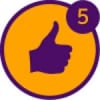Dad falls because he thinks he can walk

Hello, all, and thank you for welcoming me to this forum. I've only posted one question so far, but the answers and sense of community have been incredibly helpful.
I've got another challenge that I'm wondering if anyone else has dealt with and hopefully found a solution, even temporary.
Dad had a stroke in November. He is in an SNF. His right side was very weakened, and he was never able to recover the ability to stand, walk, or transfer, and needs assistance to toilet, get into or out of bed/wheelchair, etc. (He refused PT and OT after 60 days without much progress.)
The stroke seems to have brought on vascular dementia in addition to the beginnings of Alzheimers he had before the stroke. He doesn't remember that he has the physical disabilities, and won't believe it when he is told. He regularly tries to get up to use the toilet, walk to the door or go to the lunch room, etc. Most of the time, he tries, realizes he can't do it, and then stops. But a few times, he has been able to get up, and has fallen. (He does this when he's alone and no one is watching. He's tricky that way.) We do have a rollback device on his chair.
He fell today for the third (or fourth?) time. He's been lucky so far and has come away with bumps and bruises or skin tears. But one of these days, he won't be so lucky.
Any ideas for how to help keep him safe?
Thank you for any help, and wishes of support to all of you who are caring for someone with this disease.
Comments
-
You might ask if a bed alarm would be permissible. That would alert the caregivers whenever he moves off the bed pad. Just a thought, but it might help.0
-
We had the same thing after my FIL’s hip surgery - he was mobile before the surgery (without a walker) and didn’t realize after that things had changed. The PT felt it was more of a cognition issue, the PT thought he was strong enough to walk, but he just didn’t get the concept of moving his feet.
He had a few falls too during that time. The only way we found to deal with it was eyes on, and running to assist when he got up. At one point the trying to stand was replaced with sliding down out of the chair. Either way, when we couldn’t be right next to him, we used a seatbelt (the one that goes between the legs like a child’s car seat belt) for his own safety. We did not use it all the time though, as the movement was good for his circulation and skin health.
At night we use a bed alarm pad like Ed mentioned. Our hospital bed has railings which help, but are not foolproof so we also have a mattress next to his bed.
The railings and seatbelt are NOT used in a SNF, I’m pretty sure. His MC would not allow him back without 24/7 supervision so we opted to bring him home.
0 -
Bed rails help but are not fool proof as MayFlowers stated. When our LO’s gets determined, they will try to go over, under, between, out the side, or even try to figure out how to unlatch the rails so they will come down. You can't even convince them they can no longer walk or do something else without assistance. It starts an argument. Home health just suggested to me this week, it is time to hunt for a bed alarm and/or one that clips on the collar and will alarm as soon as my LO sets up.0
-
For bed, he should have a hospital bed set as low as it can go with floor pads and perhaps a bed alarm.
SNF will not allow bed rails.0 -
I would ask for a care meeting to discuss.
It's not uncommon for a PWD post-stroke or injury to not recall physical limitations leading to falls. Your dad can't be restrained, but they may be able to lower a hospital bed and pad the floor next to it. I don't know that a motion detecting pad would bring much to the party in a SNF or if that would be allowed.
After my aunt's broken hip, she forgot she needed help which led to a series of falls and the SNFs insistence that family provide round-the-clock sitters. Alas, she had very little money and family could not afford this so her 85-year-old sister, late son's widow and her disabled daughter took shifts. It was really hard.
HB0 -
If the patient is in a facility, restraints cannot be used unless ordered by the physician. Restraints include seatbelts, wheelchair trays, or any alarm system that makes a noise. They are reluctant to order restraints because of all of the hoops that they have to jump through on an ongoing basis due to Federal and state rules. If you don't get anywhere with a care meeting at the facility, meet the with physician and see if s/he is willing to order restraints. Unfortunately, too often they wait until a patient breaks a hip and is unable to get out of their wheelchair anymore. It's a no win situation.0
-
The no restraint policy bothers me. I know the argument is that the elderly will hurt themselves worse trying to get out of a bed with rails or choke on a seatbelt or tray, but I always wonder why don’t they develop and test a better restraint and approve it for facilities? If they climb over bed rails, then use higher bed rails or a tent like they do for cribs. For the chair, we used a padded seatbelt that is designed a lot like a child’s car seat and there is no way he could slide down or up out of it. For a tray, they could make them with a pommel to go between the legs like they do children’s high chairs. I don’t understand why chemical restraints are deemed better than physical ones?
I’m not saying lock them in all day, but at least enough to give the caregivers a break. Their poor backs from having to pull patients up in their chairs all day.
One PT that came out said he had one patient who they just had to put a mattress on the floor in front of her chair as she was launching out of her chair to the floor dozens of times an hour, as soon as they’d put her in the chair, she launched herself right back out again. Broke many bones.
I may be simplistic but that’s my .02 worth, lol.
0 -
I agree May flowers, it’s like over simplistic rules and regulations are applied so the staff don’t have to think for themselves the best solution for the given situation, maybe meant to help them but often makes it worse for all concerned!0
-
Besides the argument that restraints can cause physical harm to a patient, they’re also frowned upon due to a loss of dignity the patient might experience. They may become more agitated due to their loss of autonomy etc… The psychological element is also a consideration in the restraint debate. That’s what I learned in my CNA class anyway.0
-
That is definitely a valid point. I guess my thinking is, in terms of dignity, having seen how distraught my FIL was repeatedly falling or sliding to the floor, I can’t imagine anything more humiliating or upsetting. He was more agitated and cried more after any falls and it affected him for days. One time he actually asked for his seatbelt to help hold him up. He is no more agitated with bed rails, trays, and seatbelts than without them in our experience with him here at home. I find it interesting that hospice nurses and doctors seem a lot more flexible on this issue.
Hand/leg restraints and such would probably really upset him, though, because he wants to move and do his bed spinning, lol
I don’t know how meds to control behavior are any more dignified, they are altering their behavior and in essence taking away their choices, just chemically.
Anyway, it just seems to me there could be some common sense, or more patient centered, individual approaches.
0 -
The regulations that now make it difficult/impossible to use restraints are due to overuse of restraints for the ease of the staff in years past. The regulatory pendulum has swung too far in the opposite direction in my opinion.0
-
May flowers wrote:Certain medications are considered to be potentially abusive restraints. Annual reviews of MC/nursing facilities by licensing organizations look at the percentage of patients taking these medications. It is a red flag is that percentage is too high. The facility where my husband lived was known in the community for being an excellent facility (due to staff ratios, training and good pay) for patients with behavioral difficulties. The owner had to be very careful not to accept too many patients that were already on behavioral related medications. Again, the regulations wagging the dog.I don’t know how meds to control behavior are any more dignified, they are altering their behavior and in essence taking away their choices, just chemically.
0 -
I think this is another example that sadly highlights the limited options we are forced to deal with. There are no good options sometimes.0
Commonly Used Abbreviations
DH = Dear Husband
DW= Dear Wife, Darling Wife
LO = Loved One
ES = Early Stage
EO = Early Onset
FTD = Frontotemporal Dementia
VD = Vascular Dementia
MC = Memory Care
AL = Assisted Living
POA = Power of Attorney
Read more
Categories
- All Categories
- 597 Living With Alzheimer's or Dementia
- 321 I Am Living With Alzheimer's or Other Dementia
- 276 I Am Living With Younger Onset Alzheimer's
- 17K Supporting Someone Living with Dementia
- 5.6K I Am a Caregiver (General Topics)
- 8.2K Caring For a Spouse or Partner
- 2.7K Caring for a Parent
- 225 Caring Long Distance
- 158 Supporting Those Who Have Lost Someone
- 17 Discusiones en Español
- 5 Vivir con Alzheimer u Otra Demencia
- 4 Vivo con Alzheimer u Otra Demencia
- 1 Vivo con Alzheimer de Inicio Más Joven
- 12 Prestación de Cuidado
- 3 Soy Cuidador (Temas Generales)
- 8 Cuidar de un Padre
- 23 ALZConnected Resources
- View Discussions For People Living with Dementia
- View Discussions for Caregivers
- Discusiones en Español
- Browse All Discussions
- Dementia Resources
- 8 Account Assistance
- 15 Help

















